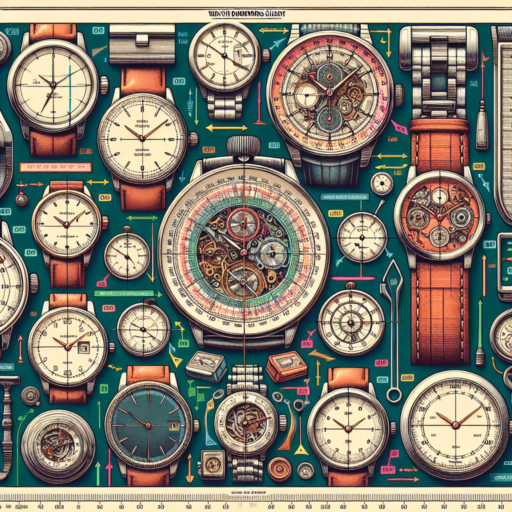What are watch dimensions?
Understanding watch dimensions is crucial for anyone interested in purchasing a new timepiece. These measurements directly influence not only the watch’s appearance on one’s wrist but also its comfort and functionality. Principally, watch dimensions encompass three key metrics: case diameter, case thickness, and lug-to-lug width. Grasping the nuances of these dimensions can help in making an informed choice that aligns with one’s personal style and comfort requirements.
Case Diameter
The case diameter is often the most noticed watch dimension, contributing significantly to the watch’s overall presence and legibility. It’s measured in millimeters across the widest part of the watch case, excluding any crown or pushers. Men’s watches typically range from 38mm to 46mm, whereas women’s watches might be smaller. Design trends do fluctuate, however, leading to variations in popular sizes over time.
Case Thickness
The thickness of the watch case is another critical dimension, impacting how the watch feels and looks on your wrist. A slimmer watch might be more comfortable and slip easily under dress cuffs, while a thicker watch could provide a bolder statement and house more complicated movements. The choice between a slim or thick case often boils down to personal preference and the watch’s intended use.
Lug-to-Lug Width
The lug-to-lug width measures the distance from the top to the bottom of the watch case, including where the bracelet or strap attaches. This dimension is vital for understanding how the watch will span across the wrist, influencing overall wearability. For individuals with smaller wrists, a watch with a shorter lug-to-lug width will tend to fit more comfortably and appear more proportionate.
How do I know my watch size?
Identifying the correct watch size for your wrist is crucial for both comfort and style. While it may seem daunting at first, determining your watch size is straightforward once you understand the key measurements involved: the case diameter and the band length.
Measure Your Wrist
To start, wrap a measuring tape around your wrist where you would normally wear a watch. Note this measurement; it’s critical for figuring out both the watch case size and band length that will best fit you. A general rule of thumb is that your watch case diameter should be proportional to your wrist size. Smaller wrists often look better with case diameters of 34mm-38mm, while larger wrists may prefer sizes up to 46mm.
Understanding Watch Case Size
The watch case size is a vital consideration when selecting a timepiece. It’s measured in millimeters across the watch’s diameter, excluding the crown. Choosing a watch with a case diameter that complements the size of your wrist enhances the watch’s appearance and comfort. For a balanced look, ensure that the watch does not extend over the edge of your wrist.
Choosing the Right Band Length
The band length is equally important as the case size. A good fit will allow the watch to sit snugly on your wrist without being too tight or too loose. Typically, watch bands come in various standard sizes, and choosing the right one depends on the circumference of your wrist. If your wrist size is 6 to 7 inches, opt for a standard women’s watch band size. For wrists 7.5 to 8 inches, a standard men’s watch band will likely be the best fit.
Is a 17cm wrist small?
Understanding wrist size is essential when it comes to selecting accessories like watches or bracelets that fit perfectly and look great. A 17cm wrist is often a topic of discussion. It falls into a category that can be considered on the smaller side of the spectrum for some individuals, especially adults. However, this measurement is seen quite differently across various contexts, such as fashion and health.
When it comes to fashion, a 17cm wrist might actually offer a sleek and refined look for watches and jewelry, allowing for a more delicate and subtle accessory choice. Specific styles and brands cater to this wrist size, providing options that enhance rather than overwhelm a smaller wrist circumference. This size is quite ideal for a wide range of watches, from classic models to modern smartwatches, ensuring that the accessories complement rather than dominate the wearer’s overall look.
In health and fitness circles, wrist measurements, including a 17cm wrist, are used to gauge body frame size. Nutritionists and fitness experts often use this metric to tailor diet and exercise plans. It is a common misconception that a smaller wrist size limits one’s potential in achieving fitness goals. On the contrary, individuals with this wrist measurement have shown remarkable versatility and resilience in various physical activities and sports.
Is a 42 mm watch too big?
When considering the size of a watch, it’s essential to understand that the appropriateness of a 42 mm watch largely depends on personal preference and wrist size. This size has become increasingly popular, balancing visibility and comfort for many users. However, to determine if a 42 mm watch is too big, several factors should be considered, including the style of the watch and the context in which it will be worn.
Understanding Wrist Size
The dimension of your wrist plays a crucial role in whether a 42 mm watch will look oversized or just perfect. Generally, if your wrist measures between 6 to 7 inches in circumference, a 42 mm case can offer a substantial, yet comfortable fit. On wrists larger than 7 inches, these watches often look more proportionate, enhancing the wearer’s style without dominating the forearm.
Style and Occasion
The style of the watch can also impact whether a 42 mm size seems too large. For example, dress watches in this size may appear more prominent and potentially overpower formal attire, where subtlety is often preferred. Conversely, sports and casual watches at 42 mm can seem perfectly at home on the wrist, given their design is meant to be bold and easily readable.
In summary, while some may find a 42 mm watch too big, especially on smaller wrists or with formal wear, others may appreciate the size for its readability and statement-making potential. It’s all about how the watch feels on your wrist and matches your personal style and the occasions you plan to wear it.









